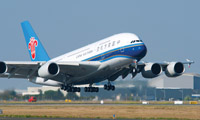Year End Review: China
CSA flexes its global muscles
December 1st 2012
China Southern Airlines (CSA) gave notice of its global ambitions in mid-year when it launched the Canton Route, linking Australia and New Zealand with Europe.Read More »
 |
| China Southern Airlines: taking on the ‘heavy hitters’ with its Canton Route |
CSA, which carries more passengers than any other airline in Asia, is the world’s third largest carrier by market capitalization and the sixth largest by fleet size. Now, it is looking to cement its place in the major league of international operators.
The Qantas-Emirates alliance, yet to be confirmed by Australia’s competition regulators, which would see the Kangaroo Route hub move from Singapore to Dubai, has been one of the big stories of the year. But CSA chairman, Si Xianmin, believes its Canton Route would make an even better gateway to Europe than the Singapore or Dubai hubs.
CSA launched its inaugural service from its home base, Guangzhou, to London’s Heathrow airport in June with three flights a week using A330s. This has been increased to a daily service. The carrier also flies to Paris and Amsterdam and through its Skyteam membership has a significant European network across the continent.
It’s no coincidence, therefore, that CSA has been developing its Australasian market during the year. It has added 10 flights to Australia in 12 months and today operates 42 services a week to five cities in Australia and seven a week to Auckland. Si has set a goal of 110 flights a week on the routes by 2015.
CSA was “unswervingly pushing forward in the process of internationalization and our Australian strategy is key to this development”, said Si earlier this year on a visit to Australia.
The carrier is expected to use its A380s on the route from next year. Its fifth, and last A380 on its order book, will be delivered early in 2013.
The Canton Route, linking Australasia with Europe, is a declaration of war by CSA against big boys like Qantas, Emirates and Singapore Airlines, said Orient Aviation in June.
The route from Sydney to London via Singapore is 17,152 kms, pointed out Si. Through Dubai it is even further, 17,519 kms. By way of Guangzhou, it is 16,995 kms.
“From a sheer geography standpoint, Guangzhou is the most logical transit point with the shortest transit distance,” said Si.
As China’s airline industry grows faster than anywhere else in the world, congestion in the skies and on the ground has become a major problem for the Mainland. It’s not unknown, for example, for flights between Hong Kong and the Mainland to be delayed for up to four hours, longer than the flight itself.
In January, China began introducing changes in its airspace procedures in an attempt to ease its congestion hotspots, particularly Beijing and Shanghai.
The Civil Aviation Administration of China (CAAC) announced that flights delayed more than two hours would be given priority to take off. It added that it would coordinate with the military to open provisional airspace and routes during large scale flight delays. But with more and more overseas carriers, particularly LCCs, applying to fly to the Mainland and domestic fleets growing, congestion will be a fact of life for some years to come.
The CAAC is restricting the number of LCCs using airports in Shanghai and Beijing to avoid more congestion. It is probably only a matter of time before the regulator clamps down on the growing number of overseas budget operators on its international routes.
* Instead of being deadly rivals, China’s domestic carriers and high speed rail (HSR) companies started to work together in 2012.
The rail companies were seriously eroding the profits of carriers, especially on routes of less than 500km. However, in June, Orient Aviation reported that at least two airlines were using the high speed trains as supplementary feeder traffic, bringing more passengers to both sides.
China Eastern Airlines (CEA) was the first airline to sell HSR tickets. In May, in cooperation with the Shanghai Railway Bureau, it announced enhanced connections between Shanghai’s Pudong and Hongqiao airports to Hangzhou, Suzhou, Ningbo, Wuxi and Changzhou. HSR frequencies were increased from 22 to 92 a day.
Meanwhile, CEA and Hainan Airlines partnered with the Shanghai Railway Bureau and the Yuhei Railway respectively in partnerships that allowed passengers to transfer between domestic rail travel and international air travel on one single ticket.
* Relations cooled between China and Japan in recent months as the dispute over the Diaoyu Islands in the South China Sea intensified. Air ticket sales between the two countries slumped.
However, China’s only LCC, privately operated Spring Airlines, announced in September that it intended to launch an LCC in Japan, in conjunction with a local investor.